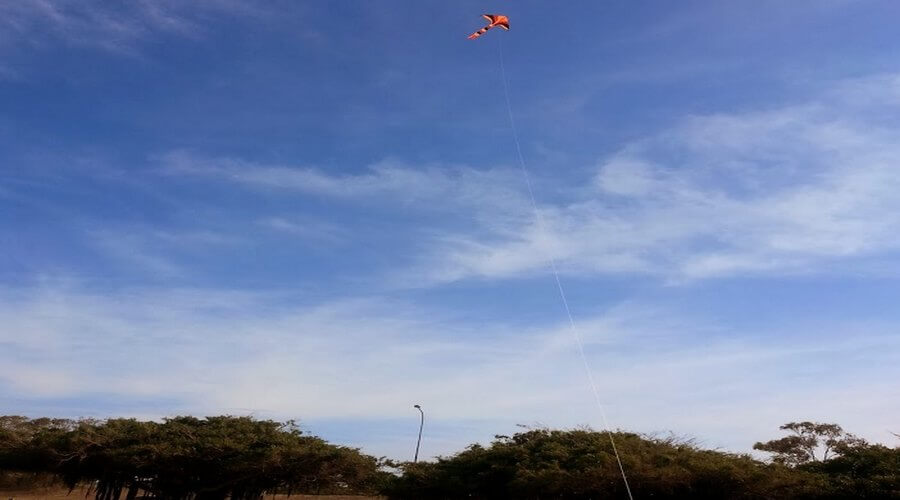Beaches are the best place to fly a kite. There are long stretches of sand to run along as well as excellent winds. These two aspects make flying a kite on the beach truly remarkable.
Not to mention the backdrop of the ocean is breath-taking! But what are kites made of? What makes them so great? While those are important questions to consider, the most important is how does flying a kite work?
Kites can be made of a variety of materials. Every kite has a frame made of wood, plastic piping, or other materials. This frame is what holds the colourful part of the kite.
This coloured part can be made of fabric, nylon, or other materials. Moreover, this component of the kite is crucial as it aids in gaining some height while flying it!
Lighter material will fly a little higher but there are even stronger lightweight versions that are long-lasting and don’t become ripped that easily. This is usually referred to as “edge material” and it is cross-stitched to be extra durable!
When to come to flying a kite, there are some basic steps to follow. It isn’t as easy as it looks! Once the basic steps have been mastered, it possible to get more advanced kites that do more elaborate tricks.
But starting off with simple steps is always key! Below are the basic steps to get some flight to a kite!
1. Choose String That Matches Weight of Kite.
The string is what is used to “reel in” or “cast out” the kite while in the air. The strong should be durable enough to withstand wind but not light enough to snap. This is really important as the string is the connector between the person on the ground and the kite in the air.
The string needs to not only be able to withstand wind but also the constant movement of being spun. Kite flying begins with the kite being held while running to gain momentum.
The kite is then released and the string is spun hand over hand to cast out more string. This helps the kite gain altitude (or get higher in the air).
It may be necessary to reduce the amount of string cast out and thus “reeling in” is the reverse motion of hand over hand to decrease the string amount.
2. Start Out With Single-Stranded String Kites.
Kites can be a single-stranded, double-stranded, or even 3 to 4 stranded. Depending on a person’s skill level will determine the right amount of strings for them! To start off, mastering the single-stranded kite is best.
Until someone gets the hang of catching a good wind and the motions of hand over hand to cast the kite string out, the single string kites are most suitable!
3. Watch Out for Power Lines.
This may seem like common sense, however, it is always important to take safety seriously. Kites should never be flown around tall trees or power lines.
These pose dangers to the person flying the kite. Kites that get caught in trees can cause tripping and kites that end up in power lines can be really dangerous.
This is why flying a kite at the beach makes for the best location. There are wide open areas to run and cast the kite up into the air. The beach truly serves a bigger purpose other than being absolutely beautiful!
These tips truly make for a great kite flying experience. This is especially true in places like Australia where there are over 10,000 beaches lining its coastlines!
Australia is known for its pristine waters and gorgeous sanded beaches. They make for excellent backdrops to any kite day on the beach.
4. Which Weather is Most Appropriate for Flying Kites? Windy conditions.
Kites need wind to fly high in the air. However too much or too little wind can really ruin a fun day on the beach flying kites. The weather should always be checked before heading out a kite to ensure the proper wind speed is available.
The ideal speed to fly a kite is said to be anywhere between 13 to 39 kph. Alternatively, a kite can be flown in winds as little as 8 kph, but the ability to gain any real altitude will be greatly reduced.
13 to 39 kph provides ample wind speeds to really pick a kite up for a flight and keep it in the air! If the winds are too strong, the kite can break or become severely damaged.
Along with appropriate winds needed to get the kite in the air, there are other weather conditions to consider. A warm, sunny day with windy conditions is the perfect combination! If it’s raining or storming out, these are not ideal and can pose danger if there’s lightning out.
Rain can inhibit a kite’s flight by preventing it from staying airborne. Having the right weather conditions really makes or breaks a day on the beach with a kite!
5. What Month is Kite Season? December and January.
Believe it or not, there is a kite season! There can be a generic blanket thrown on “kite season” as being the months where the winds and warmth are at peak times.
However, more specifically in Australia, kite season can be identified as being in the months of December and January. These are Australian’s peak summer months! Kitesurfing
This fun beach activity takes kite flying to the waters while someone is being pulled behind a jet ski or boat on a water board. It really adds to the kite experience! In Australia, kitesurfing can happen as early as October.
Flying kites is a great way to enjoy a day at the beach! They are super colourful and there is a true sense of accomplishment when it comes to flying them!
Before taking a kite out to the long golden sands of the beach, there are some things to consider. This includes great tips for flying kites and the perfect weather for flying them!
These gorgeous accessories for the beach (or even park!), are not only beautiful displays but fun to fly!
Flying a kite at the beach can take on different forms but overall, the experience is a ton of fun!
More Pages On Beaches
Not all beaches are suitable for swimming for a number of reasons. Some of these areas are more practical for sand activities or photography. It is important to know whether or not a beach is safe...
Visiting the beach is a beautiful opportunity to see mother nature at its best. There's nothing quite like hearing the waves rolling in on a soft, sandy shoreline. While visiting the beach is a...



